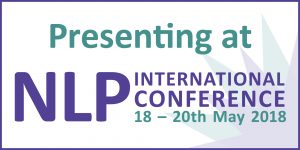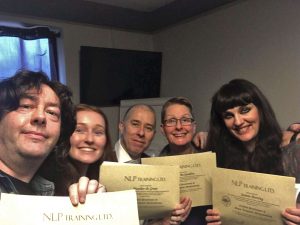How much of a difference can an NLP training make in your life?
NLP training will give you the skills to completely change your life. It’s not a magic wand, so big changes may not be immediately noticeable, which is why a clearly defined S.M.A.R.T. goal for each desired outcome is so important, as well as clearly defined evidence procedure for how you will notice when you are achieving steps along the way. Truth is – there are no big steps, only the accumulation of smaller ones. This is why it is important to avoid feeling overwhelmed by the big goals, and to understand that everything you do today moves either towards or away from those goals. Then you can concentrate on what you can actually do today that brings the goals closer. It may be as simple as an email or phone call…
Sitting on the beach on my day off from assisting at the NLP Trainers’ training in Sydney, it’s almost hard to conceive of just how much I’ve developed since being on the same beach three years earlier. I literally spent every penny I had to take Practitioner, Master Practitioner and Trainer certifications with the Tad James Company, enabling me to offer my own certifications in NLP, Hypnosis, Time Line Therapy® and NLP Coaching. Although I had originally trained in NLP to Trainer level in 1997-99 with Richard Bandler, I felt it was time for a major upgrade, and to extend myself beyond just NLP and into the other modalities. It’s a decision I will always thank myself for.
My own development
I am now in the 4th year of the NLP Master Trainer program with the Tad James Company, and I have just arrived back to the UK from Sydney, and what was the largest and most successful NLP Trainers training for them. I’m taking a moment to reflect on this awesome development program and the effect it is continually having on me.
Day by day I take action on my goals and outcomes, my directions and developments, and I focus on what I want and enforce my own boundaries – in short all the things I expect my clients to do. But when I reach Sydney each year, and assist in the coaching of the new NLP Trainers training, the changes I have gone through become unavoidably clear to me.
I’m there to help the students achieve true excellence in all things NLP, and become amongst the very best Trainers on the Planet. But I’m also there to get a sense of how much change I have created in myself in the interim year. By being around my peers I can appreciate the enormous leap I have made.
I can appreciate the development of those who are graduating the five year program before me and share in their success. I also take feedback from the students, from my own peers on the Master Trainer program, and from Adriana James, who continues to push me higher and accept no excuses for limitations.
NLP Master Trainer program
The Tad James Co. NLP Master Trainer program is a thorough and beautiful ride. It is equally empowering and humbling at the same time. This year the Coaches were achieving an unprecedentedly high bar together, supporting each other and projecting cleanly our desired outcomes, which we went on to exceed again and again.
In turn this was reflected in the students themselves, including a great number of the 90+ students hitting the hotel bar after graduation, and going well into the night celebrating together. People make friendships for life at this training.
One day back and I am already taking bookings through to May next year, and starting to think about my next visit to the Tad James Company in 2020 I look forward to being there, meeting my friends and peers for more fun and development, and doing our bit to make the planet a better place for all.
In three years I have moved from a 1-to-1 coaching model to a 1-to-many training model, offering certification trainings and work in the corporate sector. I launched a Limited Company from scratch and built it up to a very healthy position, and found every step of the way to be exciting, thanks to my own training. At each step I have been fully supported, with solid advice and feedback that has helped me form a business mind and approach to success.
The skill set I have learned has helped me in every part of my personal and professional life, whichever way you measure it. Part of my Master Trainer journey is being shown how to make my company successful by modelling their success.
So when I teach an NLP Training, I offer the same to my graduates, and this is something that will happen for you too when you decide to take the training for yourself.
What’s on offer
Firstly, the training itself is an immersive experience, that teaches the required syllabus for internationally recognised certification standards, backed up by professional bodies. But my training goes way beyond that and takes each individual as far along their own path of development as possible.
For example – I offer a lifetime of ongoing support for free after initial training. I do this because my graduates have invested in me as well as them and I want to return this investment as best as I can. I also offer a monthly NLP Practice group, which focuses on one or two aspects of the skills each time and practice them at a deeper level. I also offer new insights and developments as I gain them, so I keep my graduates up to date with their own development. Finally there is an ongoing professional coaching package to hold people’s hand through every aspect of their own development towards achieving the life they were always meant to live.
This training has changed forever for the better the way I think, feel and behave. It helped me take a great idea and turn it methodically into a thriving business. It is easy for me to make professional relationships, to nurture clients and colleagues, to make more business, to be healthier, and be be in charge of my thoughts and feelings. I have created a very compelling vision of my future, turned that into a plan, and have succeeded in every part of the first three years of that plan – which means I will achieve the next two years of the plan too. At the same time I am creating a new plan..
The difference that makes a difference
I am more creative in the way I think, I find possible solutions everywhere, I believe unshakeably in myself and my ability to achieve anything, and I have a methodology for initiating and maintaining my efforts in the right direction. And my personal life continues to get better and better through time, such that it is completely satisfying in every way.
In these and many more ways NLP training has enhanced the quality of my life through the last 22 years, and so it gives me great pleasure to pass on this understanding to as many others as possible through my NLP certification trainings and work in the corporate sector.
Are you ready to discover how you too can make the difference that really makes a difference in your life?








